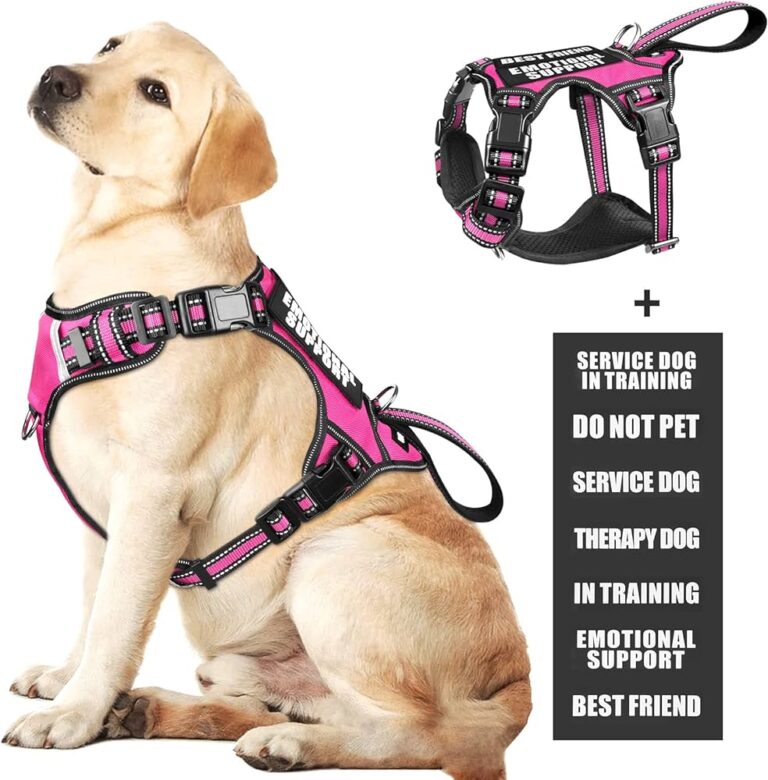Service dogs must be harnessed, leashed, or tethered, unless these devices interfere with their safe and effective performance of tasks. This requirement is to ensure the public’s safety and the proper control of the service dog.
Service dogs play an important role in assisting individuals with disabilities, providing them with the necessary support and independence to navigate their daily lives. These highly trained dogs undergo rigorous training to perform specific tasks that cater to their handler’s needs.
However, when it comes to ensuring the safety of service dogs and the general public, there are certain guidelines in place. One question that often arises is whether service dogs are required to be on a leash. We will explore the regulations regarding the use of leashes for service dogs and the reasons behind these guidelines. Understanding these rules is crucial for both dog handlers and individuals encountering service dogs in public spaces.

Credit: www.post-gazette.com
Understanding Leash Laws For Service Animals
Service dogs are generally required to be on a leash, harness, or tether while in public places, according to the Americans with Disabilities Act (ADA). However, there may be exceptions if the individual’s disability prevents the use of these devices or if they interfere with the service dog’s tasks.
Overview Of Leash Laws
In order to better understand the requirements for service animals and leashes, it’s important to have an overview of leash laws. Leash laws are regulations put in place by local governments to ensure public safety and control over animals in public areas.
Importance Of Leash Laws For Public Safety
Leash laws play a vital role in maintaining public safety. By keeping dogs on a leash, these laws prevent potential incidents such as dog attacks, aggressive behavior, or other forms of public disturbance. Leashing a service animal is essential to ensure that they are under control and able to perform their duties effectively.
Leash laws are not only important for the general public, but also for the service animal itself. By being leashed, service animals are protected from potential dangers, such as traffic accidents or running away and getting lost.
Moreover, leash laws contribute to a sense of order and respect for public spaces. They help create a harmonious environment where everyone – service animals, their handlers, and other individuals – can coexist without unnecessary disruptions.
In summary, leash laws are crucial for public safety and should be followed by all individuals, including those with service animals. Ensuring that service animals are properly leashed helps maintain control, protection, and effective performance of their tasks.

Credit: lbpost.com
Exceptions To Leash Requirements For Service Dogs
When it comes to service dogs, one of the common questions people ask is whether they have to be on a leash at all times. According to the Americans with Disabilities Act (ADA), service animals must be harnessed, leashed, or tethered, unless the individual’s disability prevents the use of these devices or if they interfere with the service animal’s safe and effective performance of tasks. However, there are certain exceptions to leash requirements for service dogs, which we’ll explore in this article.
Considerations Under The Ada
Under the ADA, service animals must generally be on a leash, harness, or tether when in public places, such as restaurants, stores, and malls. This ensures that the service animal remains under the control of its handler and minimizes any potential disruptions or safety concerns. However, there are situations where leash requirements may not apply.
Individual Disability Exemptions
Individuals with disabilities that prevent them from using a leash, harness, or tether may be exempt from these requirements. For example, someone with a physical disability that impairs their ability to handle a leash may be allowed to have their service dog off-leash. These exemptions are intended to ensure that individuals with disabilities have equal access to the benefits and assistance provided by their service animals.
In addition, sometimes using a leash, harness, or tether can interfere with a service animal’s ability to perform its tasks effectively. For instance, a service dog that assists an individual with mobility issues may need to be able to move freely without restrictions posed by a leash. In such cases, the individual may be permitted to have their service dog off-leash.
It’s important to note that exemptions to leash requirements should be determined on a case-by-case basis, taking into account the specific needs and capabilities of the individual with a disability and their service dog. The main priority is to ensure that the service dog can perform its tasks safely and effectively, while also considering the overall safety and comfort of the public.
Overall, while service animals are typically required to be harnessed, leashed, or tethered, exceptions may exist for individuals with disabilities who are unable to use these devices or if they interfere with the service animal’s tasks. The ADA aims to strike a balance between providing equal access to individuals with disabilities and maintaining public safety. So, if you come across a service dog without a leash, it could be that the handler has a valid exemption that allows the dog to be off-leash.
State-specific Regulations For Service Dogs And Leashes
Service dogs must be harnessed, leashed, or tethered in public places unless these devices interfere with their tasks or the individual’s disability prevents their use. Leash laws for dogs also apply, requiring them to be kept on a leash on public property to ensure public safety.
Leash Requirements In Texas
In Texas, there are specific regulations regarding the use of leashes for service dogs. According to the Texas Disability Law, a person with a disability who uses an assistance animal for assistance in travel or auditory awareness must keep the animal properly harnessed or leashed. This requirement ensures the safety and control of the service dog in public places.It’s important to note that failure to keep the service dog properly harnessed or leashed can have legal consequences. If someone is injured by the uncontrolled service animal, they are entitled to maintain a cause of action for damages in a court of law.Comparison With Other States
While Texas requires service dogs to be properly harnessed or leashed, it’s essential to understand that leash requirements may vary from state to state. Some states might have similar regulations, while others may have different guidelines.It is recommended to research and familiarize yourself with the specific leash regulations for service dogs in the state you reside in or plan to visit. This will help ensure you are in compliance with the local laws and will contribute to a positive and harmonious interaction between service dogs and the general public.To provide you with further insight into leash requirements in different states, here is a comparison table:| State | Leash Requirements for Service Dogs |
|---|---|
| Texas | Service dogs must be properly harnessed or leashed. |
| California | Service dogs must be on a leash unless the individual’s disability prevents the use of a leash or it interferes with the service dog’s safe and effective performance of tasks. |
| Florida | Service dogs are not required to be on a leash, but they must be under the control of their handler at all times. |

Credit: www.amazon.com
Frequently Asked Questions For Do Service Dogs Have To Be On A Leash
Do Service Dogs Use Leashes?
Service dogs must be harnessed, leashed, or tethered in public, unless it interferes with their tasks or the owner’s disability prevents it. (25 words)
What Are The Three Questions You Can Ask About A Service Dog?
Service dogs must be harnessed, leashed, or tethered while in public, unless it interferes with their tasks.
Does Your Dog Have To Be On A Leash?
Service dogs must be harnessed, leashed, or tethered in public unless it interferes with their tasks or the individual’s disability prevents it. Leash laws also apply in most communities to protect public safety and the well-being of your pet.
What Qualifies You For A Service Dog In Texas?
To qualify for a service dog in Texas, you need to have a mobility impairment, intellectual or developmental disability, hearing loss, communication disorder, or auditory awareness. The service dog must be properly harnessed or leashed for public places, unless it interferes with its work.
Conclusion
Service dogs must be harnessed, leashed, or tethered, unless the disability hinders their use or interferes with their tasks. Leash laws also require dogs to be kept on a leash while on public property for the safety of the public and the service animal.
It is crucial to keep service animals under control at all times, whether through leashes, tethers, or other means. By following these regulations, service dogs can effectively perform their duties while ensuring the safety of those around them.



